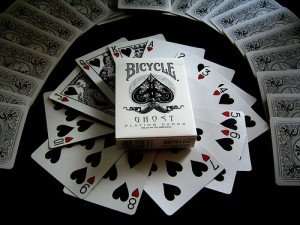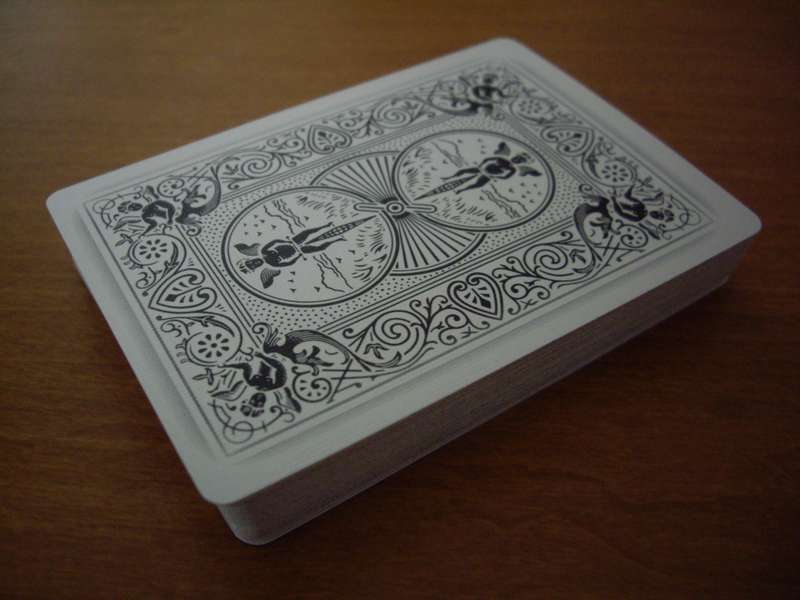
Bicycle Ghost Deck - Svengali Deck - Invisible Deck combo - In Stock in SA - Free postage
Check my rate
| Main centres: | 1-3 business days |
| Regional areas: | 3-4 business days |
| Remote areas: | 3-5 business days |

| Main centres: | 1-3 business days |
| Regional areas: | 3-4 business days |
| Remote areas: | 3-5 business days |
All three decks are the lovely White Ghost deck so you can hand out for inspection and swop the decks at any time.
Svengali deck a gaffed magicians deck where you can force reveal and do amazing predictions:
The deck alternates between normal cards and shortened cards, with the shortened cards all of the same number and suit. When the deck is riffled front to back, only the normal cards are visible; when it is riffled back to front, only the shortened cards are visible.[3]
The deck can be dribbled or riffled to create the illusion that the deck is completely ordinary. It can even be shuffled. One basic trick involves a spectator choosing a card from the deck and returning it; the card can then appear practically anywhere in the deck, making tricks like the Ambitious card incredibly simple. The final and most stunning trick is when all the cards are suddenly presented as being all the same as the initially chosen card.
Joe Stuthard's Trilby and Bi-Co Trilby Decks are variations on this deck. In the 1960s and 1970s, Marshall Brodien sold 17 million Svengali decks under the name TV Magic Cards.
While the Svengali Deck allows for the easy performance of seemingly complex tricks, the conjurer cannot allow an audience member to examine the deck. The use of a Svengali Deck can also be detected by its characteristic faster riffle and sound. Finally, because the deck is widely sold in joke and novelty shops, many laypeople are familiar with it. [4] [5]

The Invisible Deck is one of the best known card tricks. The trick's title stems from the classic presentation of this effect, in which the magician hands the spectator an imaginary, or "invisible" deck. On being handed the deck, the spectator is asked to mime the acts of removing the cards from their case, shuffling them, spreading them face-up on the table, freely selecting a card, replacing it face-down among the other face-up cards, and returning the deck to its box.
At this point, either the spectator keeps the imaginary deck while the magician removes the real deck from his pocket, or the spectator hands the imaginary deck to the magician, which suddenly becomes real in the magician's hands. Michael Close also utilizes a handling in which the invisible deck is tossed back into a paper bag, whereupon it becomes real and visible.[10] The magician then asks the spectator to name the card he/she selected, removes the deck, face-up, from its box and spreads the cards to show one face-down card. The spectator removes the card to find it is the one he/she named moments earlier.
In the more comedic version of the routine, more focus will be drawn to the part of the effect where the spectator is handling the cards. Often, the magician might criticize the spectator's card-handling abilities, or remind them to take the cards out of the case before trying to shuffle them.
A more serious routine can be performed, which focuses more on the magician's mindreading abilities and the fact that the spectator had a completely free choice of card. The magician could hand the spectator a box of cards to hold, ask them to think of, and concentrate on, any card in the deck, and then to name it. The spectator then hands the box back to the magician and the trick completed as before.
Joe Berg created the Invisible Deck in the 1930s, originally calling it the Ultra Mental Deck. It was Eddie Fields who came up with the invisible presentation after watching a patient in a psychiatric unit of a hospital shuffling an imaginary deck of cards.
The deck can be bought from magic dealers, and it requires some memorization work on the part of the performer. It is also possible to construct the deck using a regular deck and additional materials from department stores.[11][12]